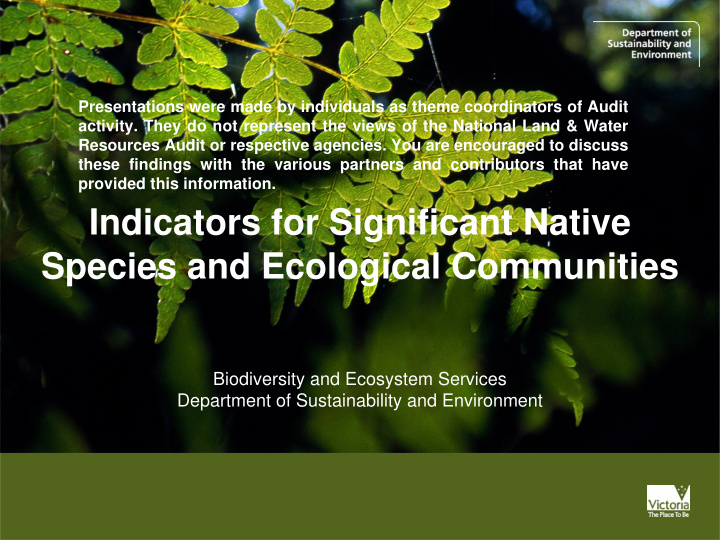



Presentations were made by individuals as theme coordinators of Audit activity. They do not represent the views of the National Land & Water Resources Audit or respective agencies. You are encouraged to discuss these findings with the various partners and contributors that have provided this information. Indicators for Significant Native Species and Ecological Communities Biodiversity and Ecosystem Services Department of Sustainability and Environment
What did we do? � Project objectives � Literature review � Questionnaire � Workshops � Design principles � Issues � BAWG presentation
Design principles � Useful at a range of scales � Enable aggregation � Easy to understand � Representative � Reliable (or at least explicit about reliability) � Cost effective implementation � Flexible – encourage organisations to get on board
What did we learn? � Major challenge: ‘from Blue Whales to Butterflies’ � Committed to MERI principles – no practice to match � Conservation status is key indicator � Has some ‘issues’ � Change due to improved knowledge � Poor fit with regional focus – averages changes � Monitoring programs are based around recovery plans or major projects (e.g. Western Shield) � Standard monitoring techniques not really appropriate
What is happening elsewhere? � CBD � Europe � US � Canada � NZ � UK � States and territories
UK Biodiversity Action Reporting System
What should we do? I UCN Red List � national scale only! � if an indicator, correct for artifact changes � need equivalent for ecological communities Trends � occurrence-level, not whole of species/community � ‘assets’ and ‘threats’ � Need to optimise – representativeness vs rigour � Good indicator for regions – link to activity
What next? � Protocol drafted � Seeking endorsement for general direction � Should be split into two or three discrete indicators � Project plan to finalise � Working group to undertake � Agencies to liaise re systems and processes
What next? � Criteria for inclusion of species and ecological communities on the basis of their ecological, evolutionary or cultural importance; � Systems and processes for aggregating IUCN Red List data for significant native species; � Improved alignment of State and Territory categories and criteria for identifying ecological communities at risk; � Measures to address the representation of reliability and uncertainty in status and trend data; � Standards for access, use and interpretation of data at various levels;
What next? � Standards for recording and interpreting trend information � Options to reduce bias and subjectivity in the collection of expert opinion, and � Options for integrating data on “trends of occurrences of significant native species and ecological communities, and the threats affecting them” with management activity, to enable more reliable analysis of effectiveness. � Measures to manage the risk that availability of information on the precise spatial location of certain taxa or ecological communities may lead to deliberate damage, destruction or theft.
Recommend
More recommend